
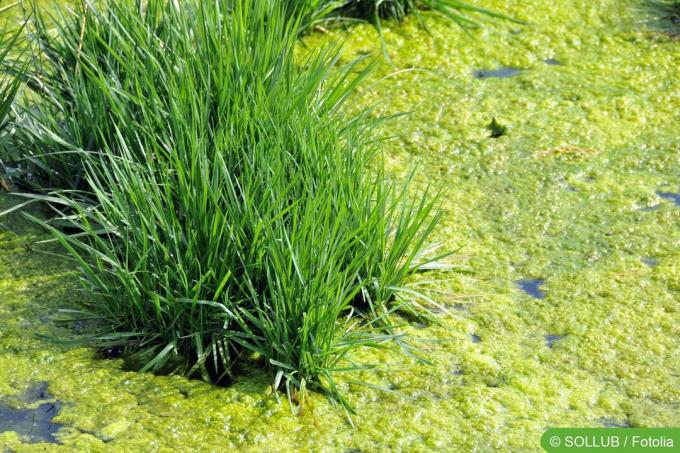
Table of contents
- Types of algae found in the garden pond
- The role of phosphate in the pond
- Remove the breeding ground from algae
- Keep pond water permanently clear
- Keep the phosphate content in the fish pond low
- Interesting facts about biological algae control
The garden pond or the swimming pond are the flagships of a garden or a facility. Especially in the swimming pond there should be no visually disturbing algae, which can also impede swimming.
Algae can usually be recognized by the slightly greenish shimmer. In most cases, these are caused by green or blue-green algae. With these two types of algae, however, the water remains clear. Water fleas can be used in garden ponds. These are harmless to humans. However, you really have to worry if the pond or swimming pond is infested with thread algae. Thread algae can cloud the water if they multiply very quickly. Other plants that are in the pond die off and consequently sink to the bottom of the pond. These begin to decompose on the ground. Decomposition processes are now set in motion, which leads to a drop in the oxygen concentration in the pond. The body of water can tip over and fish in it can even die.
Types of algae found in the garden pond
In garden ponds or swimming ponds there are a large number of different types of algae. In addition to various green and blue-green algae, the filamentous algae, microalgae and floating algae also occur here. These usually live there, insofar as the nutrient concentration of the water is optimal or normal, with many fish and plants in coexistence. However, when the phosphate concentration rises above 0.035 milligrams per liter, the living conditions of the algae are greatly improved. If there is also solar radiation, the algae can multiply explosively. This explosive proliferation is called an algal bloom. This algal bloom ensures that other creatures in the pond can no longer get the nutrients they need.
The role of phosphate in the pond
Phosphates can get into swimming ponds and garden ponds in very different ways. In most cases, however, it is the phosphates from the fish feed that cause an excess of phosphates. Many types of fish such as bitterlings, goldfish or sticklebacks find enough food in the pond to survive without additional food. If there are only such types of fish in the pond, additional feeding, as is the case with koi, for example, is not necessary. But there are also phosphates in the fish excrement, which sinks to the bottom of the pond like excessive feed. In addition, these can also get into the water via fertilizers or during heavy rainfall. However, leaves and dead plants that sink to the bottom of the pond also contain phosphates, albeit only in small amounts. However, this also contains other nutrients that ensure increased algae growth.
Remove the breeding ground from algae
Problematically, not only the algae need phosphates to thrive. Other creatures that are in the pond also depend on phosphates, nitrates and other nutrients. In principle, it can therefore be assumed that plants in the pond claim the phosphate and other nutrients for themselves. In order to remove these plants from the nutrient cycle, the aquatic plants must be cut back. However, the clippings should not remain in the water, as they will sink to the bottom and decompose there.
Algae in the pond should be fished out regularly. These can also be composted. In addition, mineral phosphate binders can be used to reduce the phosphate content. Chemical processes ensure that the phosphate is bound to the minerals and can no longer be absorbed by the algae. If there is too thick a layer of sludge on the bottom of the pond, renovating the pond can help. To do this, the water is drained from the pond and the thick layer of mulm, which consists of decayed plants and fish excrement, is removed. This layer of sludge is now replaced by a nutrient-rich substrate. Here, too, the plants are cut back.
Keep pond water permanently clear
If you want to have a clear, algae-free pond over the long term, you should ensure that all sources of phosphate are removed. The course for this is usually set when the pond or swimming pond is laid out. A slightly elevated place should be chosen for the pond, even if it doesn't look natural. This slight elevation prevents fertilizer from being washed into the pond from the surrounding area. A trench of 50-100 cm acts as an additional buffer. Coarse-grain construction sand should be filled into this trench. In addition, the location should be chosen so that it is in partial shade. Although sunlight does not directly increase the proportion of phosphate in the water, it does encourage algae growth. In addition, the diameter and depth of the pond and the bathing pond have an influence on the formation of algae. The flatter and smaller a pond is, the more frequently problems with algae occur here. The pond soil should consist of nutrient-poor sand. The water with which the pond is filled should be tested and contain less than five milligrams of phosphate per liter of water. Nutrient-rich deposits in the pond should be removed with a pond sludge vacuum cleaner. In autumn it can be useful to cover small ponds with a net. So no leaves fall into the pond or bathing pond.
Keep the phosphate content in the fish pond low
Aquatic animals such as fish or newts produce excretions that also contain phosphate. As a rule, these excretions are harmless. However, if too much fish food is fed, additional phosphates and other nutrients get into the pond, which can also be absorbed by the algae. For this reason, only as many fish should be kept in the pond as this pond can feed. If overfeeding is still necessary, installing additional filter systems can help remove algae and excess nutrients from the garden pond. This is especially the case with fish, such as koi fish, since supplementary feeding is indispensable.
Interesting facts about biological algae control
If the outside temperatures are already higher at the beginning of spring, this is normal and only slight precipitation occurs, there is usually a risk of increased algae formation in the ponds of the local garden areas. This observation can be made even in biotopes with a rather low oxygen or Nutrient content can be made. Particularly widespread are:
- yoke algae,
- filamentous green algae
- blue-green algae
Mean for the owner of an artificially created biotope algae usually nothing good, on the contrary: a lot of work in connection with a lot of time, this in part annoying, green growths from the water and from the other plants (water lilies etc.) as well as the (stone) border remove. But what needs to be done to put an end to the growth of algae?
- UVC devices are a biological and quite efficient solution, but they are suspected of causing cancer.
- The complete renewal of the water in the garden pond is certainly more time-consuming, but many times more effective.
- Algae-eating fish species are great for curbing excess algae!
- Nutrient-consuming aquatic plants, such as e.g. B. Echinodorus or also the Cryptocoryne.
 garden editorial
garden editorial I write about everything that interests me in my garden.
Learn more about algae in the pond
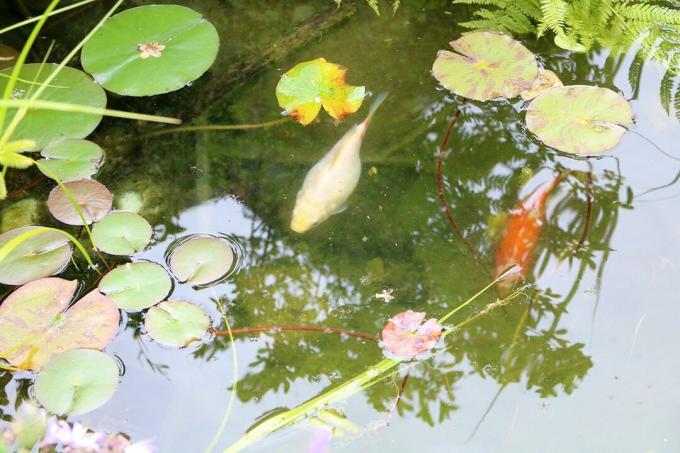
Floating algae in the pond: 10 tips for removing them
Algae infestation is not only unsightly to look at, but can also pose a threat to aquatic animals and plants. For this reason, it is advisable to always remove floating algae - read here how this works best!
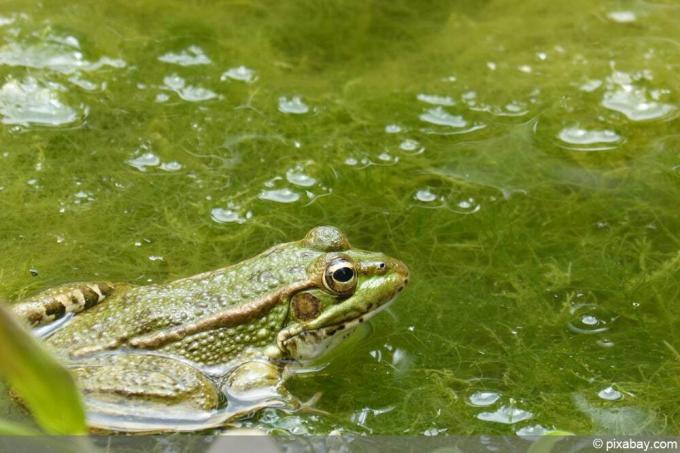
Algae eater in the pond: 5 hungry pond fish
Algae growth in the garden pond not only looks unsightly, but excessive growth can tip the entire ecosystem over. In this article we will tell you which types of fish, snails and mussels like to eat algae and what else helps against the "green plague".
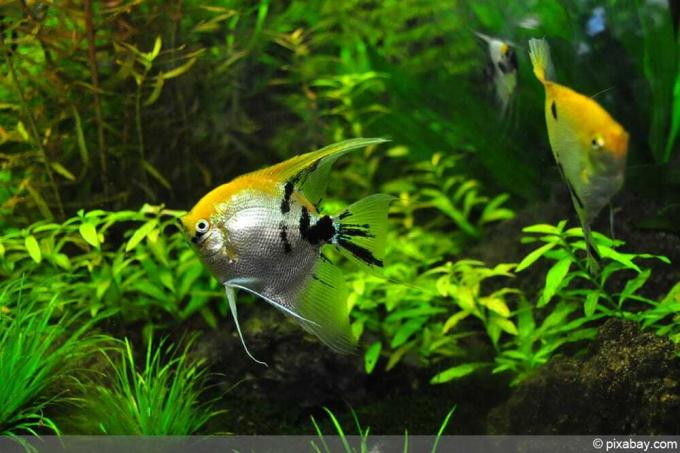
Combat thread algae in the aquarium
The right countermeasures must be taken at an early stage to ensure that the thread algae in the aquarium do not grow too rampant and become a nuisance. Otherwise, the aquatic plants can severely disturb the sensitive ecosystem of the aquarium and also negatively affect the visual appearance.
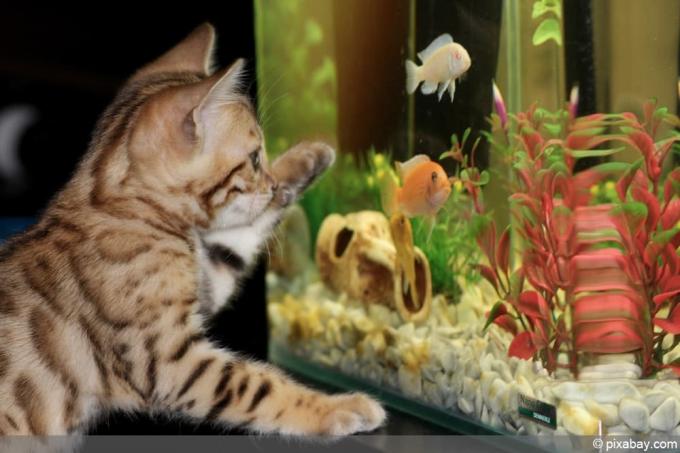
Get rid of green algae in the aquarium properly
Green algae occur in every aquarium. This is normal and part of it. It can even speak for a particularly good water quality. Only a massive increase in algae caused by too much light and too many nutrients is not normal. The green coloring and turbidity of the water means nothing other than that the biological balance has gotten out of joint. There are different green algae, also with quite different requirements. However, all benefit from an excess of food and can best be combated by depriving them of food.
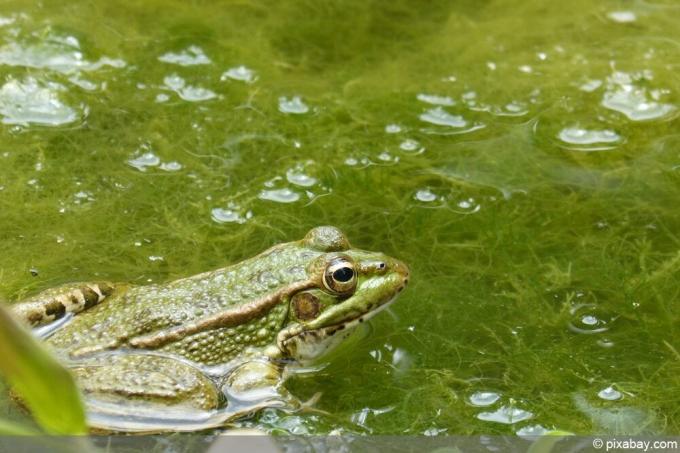
Natural remedies against thread algae
Algae in the garden pond are an absolute nuisance, but can hardly be avoided. Besides, they are useful too. They serve as food for microorganisms and also produce vital oxygen. It gets annoying when they multiply en masse.

The best home remedies for algae in the aquarium
Algae in the aquarium are absolutely natural and normally do not have to be fought. It only becomes difficult when they multiply explosively. There is a reason for this increase. It has to be found and turned off. That sounds simple, but it isn't.



